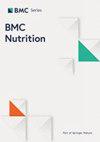Cross-continental national nutrition surveys: a narrative review
IF 1.9
Q3 NUTRITION & DIETETICS
引用次数: 0
Abstract
Many countries use national nutrition surveys (NNSs) to assess their population’s health and nutrition needs. However, NNS aims, approaches, tools, and measurements vary among countries. To date, there has been no review evaluating the NNSs and their practices worldwide to help conduct future NSSs. Therefore, this narrative review was conducted to 1) explore and tabulate current NNSs in five continents (Asia, Europe, Africa, North America, and Australia) and 2) help lay the foundation for establishing clear guidelines for future NNSs. The NNSs were identified using two approaches. First, an electronic database search was conducted with key terms in PubMed database. Second, a general web-based search on the survey webpages of governmental organizations was conducted using the same key terms to identify eligible surveys. The review included general adult population (≥ 18 years) with a cross-sectional design, excluding NNSs related to household-only surveys, specific age groups, or insufficient sample sizes. A total of 41 NNSs were identified in 37 countries across four continents: Asia (n = 15), Europe (n = 21), North America (n = 3), and Australia (n = 2). Broad differences between the surveys were identified, including survey purposes and designs, definitions of geographic areas and target groups, and dietary assessments. Currently, there are 26 ongoing NNSs, while 15 have ended. Among the ongoing NNSs, the cycles of the surveys were either at regular intervals (n = 8) or irregular intervals (n = 8). Of the 41 surveys, 24-h dietary recalls were used in 27 surveys, while only 6 surveys used diet diaries and 8 surveys relied on FFQs. Some surveys (n = 17) utilized multiple tools to assess dietary intake. Most of the surveys that assessed biochemical status (n = 12) focused on blood glucose, haemoglobin A1c (HbA1c), and lipid status, whereas some surveys (n = 6) tested for vitamin and mineral status in blood and/or urine samples. The review identified key characteristics, time frames, sampling methods, and dietary and physical assessment methods obtained from different surveys worldwide. The information organized in this review will be important for researchers, policymakers, and public health programme developers in developing and improving NNS.跨洲国家营养调查:叙述性综述
许多国家使用国家营养调查 (NNS) 来评估其人口的健康和营养需求。然而,各国 NNS 的目的、方法、工具和测量手段各不相同。迄今为止,还没有任何综述对全球 NNS 及其实践进行评估,以帮助今后开展 NSS。因此,本陈述性综述旨在:1)探索五大洲(亚洲、欧洲、非洲、北美洲和澳大利亚)当前的 NNS 并将其列表;2)帮助为未来的 NNS 制定明确的指导方针奠定基础。NNS 是通过两种方法确定的。首先,在 PubMed 数据库中使用关键术语进行电子数据库搜索。其次,使用相同的关键术语在政府组织的调查网页上进行一般网络搜索,以确定符合条件的调查。综述包括采用横断面设计的一般成人(≥ 18 岁),排除了与仅针对家庭的调查、特定年龄组或样本量不足有关的 NNS。在四大洲的 37 个国家中共发现了 41 项 NNS:亚洲(n = 15)、欧洲(n = 21)、北美洲(n = 3)和澳大利亚(n = 2)。确定了这些调查之间的广泛差异,包括调查目的和设计、地理区域和目标群体的定义以及膳食评估。目前,有 26 项国家营养调查正在进行中,15 项已经结束。在正在进行的国家营养调查中,调查周期有的是定期进行(8 项),有的是不定期进行(8 项)。在 41 项调查中,有 27 项调查使用了 24 小时膳食回顾,只有 6 项调查使用了膳食日记,8 项调查依赖于家庭膳食调查表。一些调查(n = 17)使用了多种工具来评估膳食摄入量。大多数评估生化状况的调查(n = 12)侧重于血糖、血红蛋白 A1c (HbA1c) 和血脂状况,而一些调查(n = 6)则检测血液和/或尿液样本中的维生素和矿物质状况。综述确定了全球不同调查的主要特点、时间范围、抽样方法以及饮食和身体评估方法。本综述中整理的信息对于研究人员、政策制定者和公共卫生项目开发人员开发和改进 NNS 非常重要。
本文章由计算机程序翻译,如有差异,请以英文原文为准。
求助全文
约1分钟内获得全文
求助全文
来源期刊

BMC Nutrition
Medicine-Public Health, Environmental and Occupational Health
CiteScore
2.80
自引率
0.00%
发文量
131
审稿时长
15 weeks
 求助内容:
求助内容: 应助结果提醒方式:
应助结果提醒方式:


